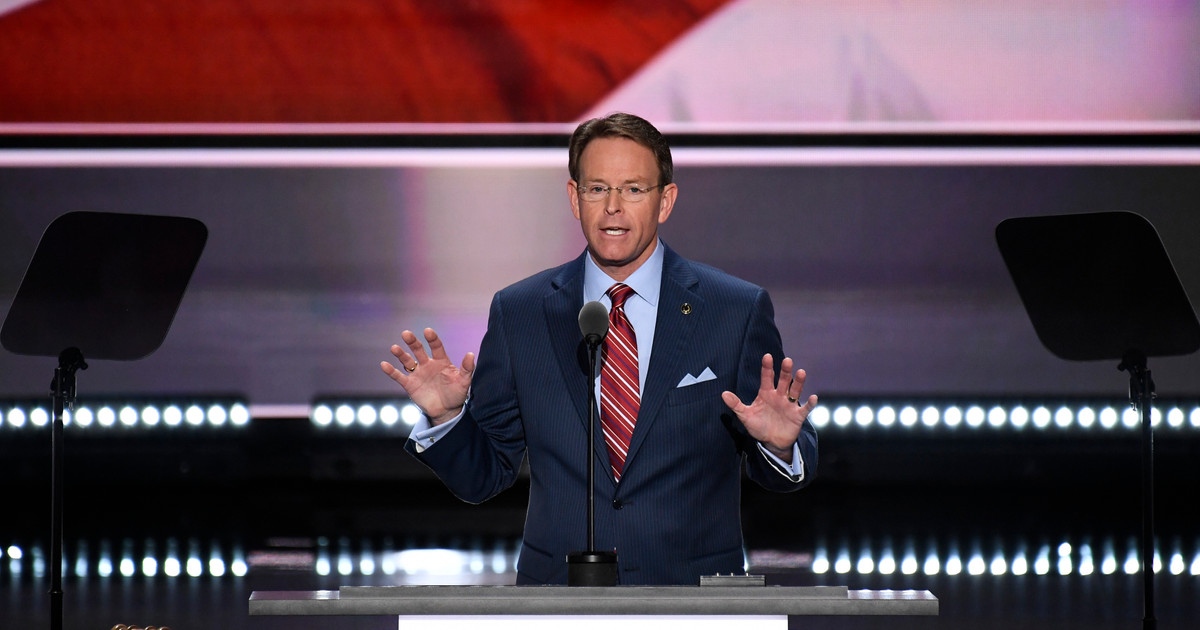Political groups and nonprofits aligned with the Democratic Party have spent nearly $44 million on advertising campaigns across five states’ Republican primaries to boost the profile of far-right candidates in California, Colorado, Pennsylvania, Illinois and Maryland.
Democrats strategy is rooted in the
belief that these candidates — many of whom spread unfounded claims that the 2020 presidential race was stolen from former President
Donald Trump — will be easier to defeat in a general election.
Democratic spending has helped secure Republican nominations for candidates in Illinois and Pennsylvania.
In Maryland, Democrats are spending on a Republican gubernatorial primary that is still ongoing and is viewed as a
tossup. But in California and Colorado, Democrats spent money elevating the profile of candidates who did not advance to the general election.
Democratic spending helps Republican candidates in Illinois and Pennsylvania
In Illinois, Democratic incumbent Gov.
J.B. Pritzker and the
Democratic Governors Association dropped
$35 million on ads attempting to influence Illinois’ Republican gubernatorial primary –
more than any office is believed to have ever spent to meddle in another party’s primary – putting Illinois’ gubernatorial race on track to be the
most expensive non-presidential election in United States history.
Ads purchased by Pritzker allies
attacked the more moderate Aurora Mayor
Richard Irvin in the Republican primary and
drew attention to the more far-right candidate, state Sen.
Darren Bailey. Pritzker’s ad buy for the primaries was more than
triple what Bailey had raised for his own campaign.
Bailey, who was
endorsed by Trump, rose to prominence in Illinois politics when he co-sponsored a bill that
proposed allowing rural Illinois to separate from Chicago and form a “New Illinois” state. After a 2019 state legislative session over a bill guaranteeing Illinois residents abortion rights – which Bailey vehemently opposed – he
criticized a fellow lawmaker for having “the gall to bring up the separation of church and state.” Painted on the door of his campaign bus is the Bible verse
Ephesians 6:10-19, which calls for followers to wear God’s armor in a battle against “evil rulers.”
Bailey won the nomination with
55.2% of the vote. Although Irvin was
leading Bailey in polls as late as May, he came in second with only 18.6% of the vote.
Since winning the nomination, Bailey, a staunch
gun rights activist, has already found himself embroiled in controversy after he
stated “let’s move on” in a Facebook livestream hours after the Highland Park parade shooting.
In Pennsylvania’s race for governor, Democratic gubernatorial candidate and state Attorney General
Josh Shapiro dropped $840,000 on TV ads highlighting the stances of Republican gubernatorial candidate and state Sen.
Doug Mastriano — more than double what Mastriano spent on his own ad buys.
Shapiro’s ads
call Mastriano, whose campaign
bused rally-goers to the Capitol the day of the Jan. 6 riots and has been
subpoenaed by the Jan. 6 committee, one of “Trump’s strongest supporters” and highlight his belief that the 2020 presidential election was stolen.
“I’m going to have to send him a thank you card,” Mastriano told a
local news outlet after seeing Shapiro’s ads.
Mastriano
won his primary with 43.8% of the vote, beating out the more moderate second place vote-getter, former U.S. Rep.
Lou Barletta by more than 23 percentage points. Mastriano, if elected in November, would have the
power to appoint Pennsylvania’s next secretary of state, a crucial office that would oversee how Pennsylvania’s federal elections are managed and certified.
“For weeks before the primary election, both public and private polling indicated that Doug Mastriano was poised to become the Republican nominee,” Will Simons, a spokesman for the Shapiro campaign, told OpenSecrets. “The contrast in this race could not be more clear – and that’s why our campaign was prepared to start the general election early and make sure Pennsylvanians knew Mastriano’s real record.”
Trump, who won Pennsylvania in 2016’s presidential election and lost the state by only 1 percentage point in 2020,
endorsed Mastriano’s run for governor.
Democratic efforts prove unsuccessful in California, Colorado
In California and Colorado, Democrats spent millions of dollars in several Republican primaries in order to try and elevate more radical right wing candidates. In these instances, though, Democratic efforts did not succeed.
In California’s 22nd Congressional District, a
toss-up district in the Central Valley, Democrats spent over
$110,000 on political ads to elevate
election-denier Chris Mathys over his opponent Rep.
David Valadao (R-Calif.), one of
few Republicans who
voted to impeach Trump in January 2021.
“David Valadao claims he’s Republican ― yet, David Valadao voted to impeach President Trump,” states the narrator in the ad paid for by
House Majority PAC, a super PAC aligned with
House Democratic leadership and House Speaker Nancy Pelosi (D-Calif.).
“We have never communicated with the Pelosi-linked SuperPAC and had no involvement in their campaign against Congressman Valadao,” Mathys told OpenSecrets by email.
Despite
House Majority PAC’s efforts, Valado
won 25.6% of the vote in the June 8 primary and Mathys won 23.1% of the vote. Valadao will go on to face the Democratic nominee, state Assemblymember
Rudy Salas in November.
In Colorado, a similar story has unfolded – albeit with significantly more funding. The Colorado Sun
reported that Democrats spent nearly $7 million to elevate more far-right Republican candidates running for governor, U.S. Senate and to represent the 8th Congressional District – about $4 million more than Republicans spent on their own primaries.
Democratic-aligned PACs and nonprofits
spent just over $4 million on this type of ad to attempt to elevate candidate
Ron Hanks’
conservative credentials over his more moderate opponent
Joe O’Dea in Colorado’s U.S. Senate race. Hanks previously
voiced his belief that the 2020 presidential election was stolen from Trump and was one of several lawmakers who
attended the Jan. 6 rally that preceded the U.S. Capitol riot. Despite these ads, O’Dea
beat Hanks in the primary, winning by 9 percentage points.
In the state’s gubernatorial primary, Democratic-aligned PAC Colorado Information Network and liberal nonprofit ProgressNow Colorado
dropped almost $2 million to bolster the profile of former Parker Mayor
Greg Lopez over his opponent
Heidi Ganahl. Lopez, similar to other candidates on the Democrats’ funding list,
believes the 2020 presidential election was stolen from Trump. Ganahl defeated Lopez at the ballot box, with results
showing Ganahl ahead of Lopez by almost 7 percentage points.
Lastly, in the Republican primary for Colorado’s 8th Congressional District,
House Majority PAC and other Democratic-aligned PACs
dropped nearly $300,000 on TV and digital ads that boosted the profile of
Lori Saine, a candidate who
championed herself as “the most conservative candidate in the race.” These ads were not enough to topple the more moderate frontrunner state Sen.
Barbara Kirkmeyer, and Saine
finished third in the primary.
Upcoming Maryland gubernatorial primary the next target of Democratic spending
In Maryland’s upcoming gubernatorial primary, a similar strategy of Democratic meddling has occurred. The Democratic Governors Association’s
DGA Action super PAC spent
hundreds of thousands of dollars on airtime in July targeting the Baltimore TV market to air ads featuring Trump-endorsed Republican gubernatorial candidate
Dan Cox. Cox
helped bus constituents to the rally that preceded the Jan. 6 riots at the Capitol, and in a since-deleted tweet called former Vice President
Mike Pence a traitor for certifying 2020 presidential election results.
The
ad calls Cox “Trump’s hand picked candidate” and states that Cox will “protect the 2nd amendment at all costs.” Like other ads Democrats have run in other Republican primaries, although the ad is framed like an attack ad on Cox, the ad raises awareness about Cox generally, and could additionally energize Republican primary voters who agree with Cox’s stances even though they do not align with the views of Maryland’s general electorate.
“Given Cox’s front-runner status and radical MAGA stances, we are starting the general election early and wasting no time to hold him accountable,” Sam Newton, a spokesman for the DGA,
said in a statement.
According to most recent polling numbers, Cox and his more moderate opponent, former Secretary of the Maryland Department of Commerce
Kelly Schulz, are locked in a
statistical tie. Maryland’s primary is Tuesday, July 19.
Long-term consequences for Democratic strategy loom
Funding more radical Republican candidates that Democrats think will be easier competition in the general election is not an entirely new strategy. Former Sen.
Claire McCaskill (D-Mo.), who served in the Senate from 2007 to 2019, used the strategy with success in her bid for re-election in 2012. In the last two weeks of her campaign, McCaskill spent
$1.7 million on ads that boosted radical tea party candidate
Todd Akin in his primary election – more than Akin had spent on his candidacy in his entire campaign.
The gamble paid off: Akin won the Republican nomination with
36% of the vote. Akin then lost the general election to McCaskill.
Despite her victory, McCaskill warns that Democrats’ attempts to recreate her success should be approached with caution.
“There certainly are risks, and it’s certainly different today than it was a decade ago,” McCaskill told
NPR. “When Todd Akin said what I expected him to say, something that was off the wall in the general election, unlike today, the Republican leadership all came together and rejected him … I’m not sure you could count on Republican leaders to stand up and reject a candidate that said things that were abhorrent to most voters.”
McCaskill’s warnings evoke lessons from the 2016 presidential election. While Democrats did not spend money on advertisements in the same manner as these Republican primaries, then-Democratic presidential candidate
Hillary Clinton’s campaign attempted to “
elevate”
Trump’s Republican primary bid through an intentional media campaign in hopes he would be an easier opponent in the general election. Trump went on to win the general election and became the 44th President of the United States.
Democratic efforts to elevate more radical Republican candidates comes with an inherent risk that if those candidates win the general election, Democrats will have played a direct role in getting them elected.
Some Democratic Party operatives have criticized the strategy.
“I think it’s very dangerous and potentially very risky to elevate people who are hostile to democracy,” Democratic political strategist Howard Wolfson told the
Washington Post. “Either this is a crisis moment or it isn’t. And if it is — which it is — you don’t play cute in a crisis.”
Even if candidates like Bailey and Mastriano do not go on to win their general election, there is an additional concern that by helping them secure a victory in their respective primaries, Democrats have helped to legitimize and normalize their political platforms, which otherwise would have been viewed as fringe.
As
Thomas Devore, the Republican nominee for the
Illinois attorney general race and an ally of gubernatorial nominee Bailey, told the
New York Times, “Whether or not Darren and I win the general election, if we can at least get control within our own party, I think long-term we have an opportunity to be successful.”









